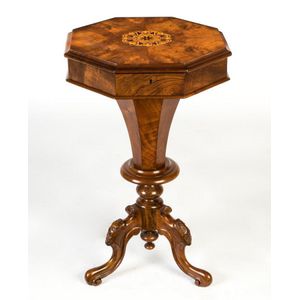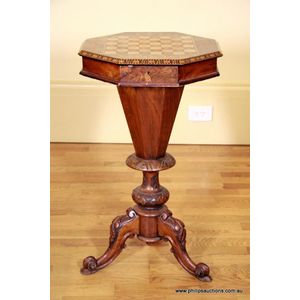Victorian Rosewood Work Table with Elaborate Carvings
You must be a subscriber, and be logged in to view price and dealer details.
Subscribe Now to view actual auction price for this item
When you subscribe, you have the option of setting the currency in which to display prices to $Au, $US, $NZ or Stg.
- Finial - An architectural decoration, found on the upper parts of of an object. On furniture they are usually found on pediments, canopies and shelf supports. On smaller ceramic or silver items, such as spoons, they may decorate the top of the item itself, or the lid or cover where they provide a useful handle for removal.
Finials have a variety of shapes and forms. They may be urn-shaped, baluster shaped round or spiral, but usually taper into an upper point. Many real life shapes may also be used as finials, such as pineapples, berries, pinecones, buds, lotus and acorns. Sometimes animals such as a lion are depicted, or fish and dolphins. - Tripod Base - A type of base used on small tables in the 18th and 19th century, consisting of either a stem to a three legged pillar, or three legs attached to the top. The former was derived from the candle stand, which has a small top and a long stem, terminating in the three legged pillar.
In the 19th century this type of base was popular on wine and occasional tables, and its use extended into larger centre, breakfast and drum tables. - Rosewood - A dense timber that varies in shade to very light brown to almost black. When rosewood is cut and sanded the colour of the timber will turn black, and after polishing and exposure to daylight, the surface will gradually lighten over time to light brown with black streaks.
The name comes from the odour emanating from the timber when it is planed, sanded or cut.
Rosewood was very popular for use in Victorian furniture in the second half of the 19th century, and at that time most of the rosewood was imported from Brazil. However it also grows in India and Indonesia.
It is used in the sold for chairs and table legs, but for carcase furniture such as side cabinets and bookcases, and for table tops it is always used as a veneer. - Victorian Period - The Victorian period of furniture and decorative arts design covers the reign of Queen Victoria from 1837 to 1901. There was not one dominant style of furniture in the Victorian period. Designers used and modified many historical styles such as Gothic, Tudor, Elizabethan, English Rococo, Neoclassical and others, although use of some styles, such as English Rococo and Gothic tended to dominate the furniture manufacture of the period.
The Victorian period was preceded by the Regency and William IV periods, and followed by the Edwardian period, named for Edward VII (1841 ? 1910) who was King of the United Kingdom and the British Dominions and Emperor of India for the brief period from 1901 until his death in 1910.
This item has been included into following indexes:
Visually similar items

A marquetry inlaid burr walnut sewing table, English, 19th century, 74 cm high, 48 cm diameter

A fine Victorian walnut games and work table, 19th century. The octagonal table with a parquetry games board top having a delightful fitted interior with little compartments and a deep conical section lined in decorative paper, some sections with padded si

Mid Victorian games table, mahogany carved pedestal base, and felt top

A William IV rosewood fold over tea table rounded rectangular, raised on a turned standard and four scroll supports, brass caps and castors, 96.5 x 73 x 50 cm
